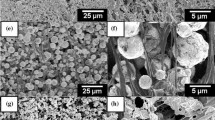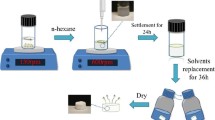Abstract
Unidirectional freezing followed by photopolymerization at subzero temperatures was used to obtain highly air-permeable monoliths with ordered porous structures. Scaffolds were obtained from aqueous solutions of a poly(ethylene glycol)dimethacrylate (PEGDMA) oligomer, a photosensitizer and a reducing agent. Solutions were vertically frozen in liquid nitrogen at a controlled rate to induce the oriented growth of ice crystals and then cryo-photopolymerized under blue-light irradiation. Ice crystals were finally removed under vacuum producing macroporous hydrophilic networks with aligned pores. Porosities ranged between 80 and 95%, depending on the initial concentration of PEGDMA. The influence of processing variables on the final properties of the materials was addressed, concerning particularly the effect of porosity and freezing directionality on air permeability. Compared to porous PEGDMA-based monoliths with non-aligned macropores, gas permeability was two to three times higher for oriented scaffolds at the same porosity level, a fact explained by the easier transport of gas molecules through the aligned structures. However, the role of pore orientation on gas permeability was shown to be less marked as porosity increased. The results demonstrate that the use of unidirectional freezing strongly increases the permeability of monolithic samples up to values usually required, for instance, in tissue engineering applications (higher than 2D). These findings provide new perspectives on pore design principles toward future scaffolding of polymeric cross-linked matrices.








Similar content being viewed by others
References
Peppas NA, Huang Y, Torres-Lugo M, Ward JH, Zhang J (2000) Physicochemical foundations and structural design of hydrogels in medicine and biology. Annu Rev Biomed Eng 2:9–29
Hentze H-P, Antonietti M (2002) Porous polymers and resins for biotechnological and biomedical applications. Rev Mol Biotechnol 90:27–53
Plieva FM, Galaev IY, Mattiasson B (2007) Macroporous gels prepared at subzero temperatures as novel materials for chromatography of particulate-containing fluids and cell culture applications. J Sep Sci 30:1657–1671
Petrov P, Petrova E, Tsvetanov CB (2009) UV-assisted synthesis of super-macroporous polymer hydrogels. Polymer 50:1118–1123
Berillo D, Volkova N (2014) Preparation and physicochemical characteristics of cryogel based on gelatin and oxidised dextran. J Mater Sci 49:4855–4868. doi:10.1007/s10853-014-8186-3
Dario Arrua R, Hilder EF (2015) Highly ordered monolithic structures by directional freezing and UV-initiated cryopolymerisation. Evaluation as stationary phases in high performance liquid chromatography. RSC Adv 5:71131–71138
Ertürk G, Mattiasson B (2014) Cryogels-versatile tools in bioseparation. J Chromatogr A 1357:24–35
Zhang H, Chiao M (2015) Anti-fouling coatings of poly(dimethylsiloxane) devices for biological and biomedical applications. J Med Biol Eng 35:143–155
Haryanto Singh D, Han SS, Son JH, Kim SC (2015) Poly(ethylene glycol) dicarboxylate/poly(ethylene oxide) hydrogel film co-crosslinked by electron beam irradiation as an anti-adhesion barrier. Mater Sci Eng, C 46:195–201
Mandy SH (1983) A new primary wound dressing made of polyethylene oxide gel. J Dermatol Surg Oncol 9:153–155
Chatterjee S, Sen Gupta S, Kumaraswamy G (2016) Omniphilic polymeric sponges by ice templating. Chem Mater 28:1823–1831
Ma Q, Cheng H, Fane AG, Wang R, Zhang H (2016) Recent development of advanced materials with special wettability for selective oil/water separation. Small 12:2186–2202
Ge J, Zhao H-Y, Zhu H-W, Huang J, Shi L-A, Yu S-H (2016) Advanced sorbents for oil-spill cleanup: recent advances and future perspectives. Adv Mater 28:10459–10490
Hernandez C, Gawlik N, Goss M, Zhou H, Jeganathan S, Gilbert D, Exner AA (2016) Macroporous acrylamide phantoms improve prediction of in vivo performance of in situ forming implants. J Control Release 243:225–231
Tsujimoto T, Kitagawa T, Yoneda S, Uyama H (2017) Fabrication of amine-functionalized acrylic monoliths via thermally induced phase separation and their application for separation media. J Porous Mater 24:233–239
Deville S (2013) Ice-templating, freeze casting: beyond materials processing. J Mater Res 28:2202–2219
Moghadam MZ, Hassanajili S, Esmaeilzadeh F, Ayatollahi M, Ahmadi M (2017) Formation of porous HPCL/LPCL/HA scaffolds with supercritical CO2 gas foaming method. J Mech Behav Biomed Mater 69:115–127
Shi B, Shlepr M, Wang JH, Wideman G (2014) New breathable films using a thermoplastic cross-linked starch as a porogen. J Appl Polym Sci. doi:10.1002/app.41016
Kim H, Ahn KH, Lee SJ (2017) Conductive poly(high internal phase emulsion) foams incorporated with polydopamine-coated carbon nanotubes. Polymer 110:187–195
Huang X, Peng Y, Pan J, Zhang W, Zhou W, Zhu H, Liu S (2017) Efficient adsorption of oil by hydrophobic macroporous polymer synthesized with the emulsion template and magnetic particles on the surface. J Appl Polym Sci 134:44731–44739
Ikem VO, Menner A, Horozov TS, Bismarck A (2010) Highly permeable macroporous polymers synthesized from pickering medium and high internal phase emulsion templates. Adv Mater 22:588–3592
Mounesi Rad S, Khorasani MT, Daliri Joupari M (2016) Preparation of HMWCNT/PLLA nanocomposite scaffolds for application in nerve tissue engineering and evaluation of their physical, mechanical and cellular activity properties: nerve tissue engineering, phase separation, multi-walled nanotubes. Polym Adv Technol 27:325–338
Wang Z, Shen X, Han NM, Liu X, Wu Y, Ye W, Kim J-K (2016) Ultralow electrical percolation in graphene aerogel/epoxy composites. Chem Mater 28:6731–6741
Zhao D, Zhu J, Zhu Z, Song G, Wang H (2014) Anisotropic hierarchical porous hydrogels with unique water loss/absorption and mechanical properties. RSC Adv 4:30308–30314
Zhang H, Hussain I, Brust M, Butler MF, Rannard SP, Cooper A (2005) Aligned two- and three-dimensional structures by directional freezing of polymers and nanoparticles. Nat Mater 4:787–793
Dhainaut J, Piana G, Deville S, Guizard C, Klotz M (2014) Freezing-induced ordering of block copolymer micelles. Chem Commun 50:12572–12574
Romeo HE, Hoppe CE, López-Quintela MA, Williams RJJ, Minaberry Y, Jobbágy M (2012) Directional freezing of liquid crystalline systems: from silver nanowire/PVA aqueous dispersions to highly ordered and electrically conductive macroporous scaffolds. J Mater Chem 22:9195–9201
Barrow M, Eltmimi A, Ahmed A, Myers P, Zhang H (2012) Frozen polymerization for aligned porous structures with enhanced mechanical stability, conductivity, and as stationary phase for HPLC. J Mater Chem 22:11615–11620
Ozmen MM, Fu Q, Kim J, Qiao GG (2015) A rapid and facile preparation of novel macroporous silicone-based cryogels via photo-induced thiol–ene click chemistry. Chem Commun 51:17479–17482
Zant E, Blokzijl MM, Grijpma DW (2015) A combinatorial photocrosslinking method for the preparation of porous structures with widely differing properties. Macromol Rapid Commun 36:1902–1909
Seuba J, Deville S, Guizard C, Stevenson AJ (2016) Gas permeability of ice-templated, unidirectional ceramics. Sci Technol Adv Mater 17:313–323
Okaji R, Taki K, Nagamine S, Ohshima M (2012) Preparation of porous honeycomb monolith from UV-curable monomer/dioxane solution via unidirectional freezing and UV irradiation. J Appl Polym Sci 125:2874–2881
Crivello JV, Sangermano M (2001) Visible and long-wavelength photoinitiated cationic polymerization. J Polym Sci A Polym Chem 39:343–356
Russell GT, Napper DH, Gilbert RG (1988) Initiator efficiencies in high-conversion bulk polymerizations. Macromolecules 21:2141–2148
Zhu S, Tian Y, Hamielec AE, Eaton DR (1990) Radical concentrations in free radical copolymerization of MMA/EGDMA. Polymer 31:154–159
Petzold G, Aguilera JM (2009) Ice morphology: fundamentals and technological applications in foods. Food Biophys 4:378–396
Acknowledgements
The financial support of the following institutions is gratefully acknowledged: National Research Council (CONICET), National Agency for the Promotion of Science and Technology (ANPCyT, Argentina, PICT012-2235 and PICT10-1008) and University of Mar del Plata (15/G374).
Author information
Authors and Affiliations
Corresponding author
Ethics declarations
Conflict of interest
Authors declare no conflicts of interest for this work.
Electronic supplementary material
Below is the link to the electronic supplementary material.
Rights and permissions
About this article
Cite this article
Schroeder, W.F., Williams, R.J.J., Hoppe, C.E. et al. Unidirectional freezing as a tool for tailoring air permeability in macroporous poly(ethylene glycol)-based cross-linked networks. J Mater Sci 52, 13669–13680 (2017). https://doi.org/10.1007/s10853-017-1460-4
Received:
Accepted:
Published:
Issue Date:
DOI: https://doi.org/10.1007/s10853-017-1460-4




